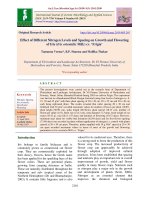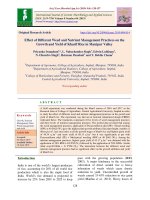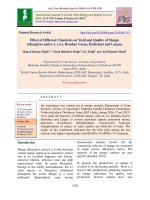Effect of different treatments on spawn run time of paddy straw mushroom, Volvariella Volvacea
Bạn đang xem bản rút gọn của tài liệu. Xem và tải ngay bản đầy đủ của tài liệu tại đây (156.05 KB, 5 trang )
Int.J.Curr.Microbiol.App.Sci (2019) 8(3): 1713-1717
International Journal of Current Microbiology and Applied Sciences
ISSN: 2319-7706 Volume 8 Number 03 (2019)
Journal homepage:
Original Research Article
/>
Effect of Different Treatments on Spawn Run Time of Paddy Straw
Mushroom, Volvariella volvacea
Gaikwad Mahesh Balaso1*, Krishan Kumar Mrig1, Surjeet Singh2,
Challa Nalini3 and Panma Yankit3
1
Department of Entomology, 2Department of Plant Pathology, Choudhary Charan Singh
Haryana Agricultural University, Hisar, Haryana, India
3
Department of Entomology, Dr YS Parmar University of Horticulture and Forestry,
Nauni, Solan, HP, India
*Corresponding author
ABSTRACT
Keywords
Paddy straw
mushroom,
Spawn run time,
Novaluron,
Chlorpyrifos,
Hot water
Article Info
Accepted:
12 February 2019
Available Online:
10 March 2019
The experiment laid out at mushroom production technology laboratory of
Department of Plant Pathology, Haryana Agricultural University during
August 2013 and April 2014. Paddy straw mushroom was raised by using
standard production technology given by DMR, Solan. Total ten treatments
and control replicated three times were evaluated for effect on spawn run time.
The results showed that maximum time taken for spawn run time recorded in
control, however minimum in Novaluron 10 EC (0.5 ml/l) which was
statistically at par with Chlorpyrifos 20 EC (4 ml/l) and Novaluron (1 and 1.5
ml/l) treatment. All hot water treatments and different concentration of
Novaluron significantly lower(less time) than control.
Introduction
About 200 types out of more than 3000 edible
mushroom have been produced under
controlled conditions all over world. India is
home to more than 300 varieties of
mushrooms found in the wild (Singh et al.,
2018). The global mushroom production (in
tonnes) ranks as per FAO Statistics-2016 was
estimated i.e., China (7797929)>USA
(260140)>Netherlands (300000) >Polands
(260140) and India (29992) (FAO, 2016).
Paddy straw mushroom also called as tropical
mushroom, is an edible mushroom of the
tropics and subtropics, Volvariella mushrooms
account for 7% of total production of
cultivated mushrooms in the India (Sharma et
al., 2017). In India this mushroom was first
cultivated was the first to be cultivated in
India as early as 1943 by Thomas and his
1713
Int.J.Curr.Microbiol.App.Sci (2019) 8(3): 1713-1717
associates at Coimbatore. In India, nineteen
edible species of Volvariella have been
reported nevertheless most cultivation
methods have been formulated only for three
species namely, V. esculenta (Mass) Sing., V.
diplasia (Berk and Br.) Sing. and V. volvacea
(Bull. ex Fr.) Sing.(Singh et al., 2018).
Like most vegetables, mushrooms are a good
source of minerals. V. volvacea is known to be
rich in potassium, sodium and phosphorus and
together with calcium and magnesium, these
constitute 56 to 70% of the total ash content
(Li and Chang, 1982). The approximate
composition of fresh paddy straw mushroom
(100g) i.e., Moisture 90.40g> Protein
3.90g>Crude fibers 1.87g > Ash 1.10g> Fat
0.25g > Ascorbic acid 18.00 (mg) >Calcium
5.60 (mg) > Niacin 2.40 (mg) > Iron 1.70 (mg)
> Riboflavin 0.61 (mg) >Potassium 0.32 (mg)
>Thiamine 0.14 (mg) > Phosphorus 0.10 (mg)
and Amino acid contents of paddy straw
mushroom (mg/100g protein) i.e., Valine 6.8>
Isoleucine 5.5> Phenyl alanine 4.9> Lysine
4.3> Threonine 4.2> Arginine 4.1> Leucine
3.5> Histidine 2.1> Tryptophane 1.1>
Methionine 0.9 (Ahlawat et al.,2006; Ahlawat
and Tewari, 2007). For the raising of this
mushroom some chemicals and physical
treatments were used for management of pest
and diseases simultaneously, effect of these
treatment on spawn run of mushroom need to
study. These studies were carried out to study
the effect of different chemicals, botanicals
and physical treatments on spawn run time.
Materials and Methods
Paddy straw mushroom strain Vv-01 was
cultivated under seasonal condition using
standard packages of practices. The
insecticides/ botanicals were added in the
water used for wetting of substrate. The details
of insecticides/botanicals treatments and their
concentration used in the experiment are given
in table 1.
Insecticide treatment
Four insecticides viz., Nimbecidine 300ppm at
5 ml, Achook 1500ppm at 4 ml, Novaluran 10
EC at 0.5, 1.0 and 1.5 ml and Chlorpyrifos 4
ml per litre of water added at time of substrate
wetting, paddy straw bundles were dipped in
insecticides solution.
Hot water treatment
The bundles of paddy straw soaked in water
and submerged in hot water at 80-90oC for 10,
20, 30 minutes.
Preparation of neem seed kernel extract
Neem seed powder was prepared from field
collected seeds of neem with the help of
grinding machine. Powder was soaked in
water overnight and strained through muslin
cloth. Neem seed kernel extract 2 ml per litre
of water solution was prepared and paddy
straw bundles were dipped in NSKE solution.
Observation on time taken for spawn run were
recorded by the visual basis observation when
whole of bed was covered with mycelium.
Data analysis
Data were analysed by using the OPSTAT
software of CCS, Haryana Agriculture
University, Hisar, Haryana.
Results and Discussion
The data recorded during August 2013 (Table
1) revealed that the lowest spawn run time in
case of novaluron 10 EC @ 0.5 ml and
chlorpyrifos 20 EC @ 4 ml was 7.6 days as
compared to control (10 days) which was at
par with other treatments i.e. achook 1500
ppm @ 4 ml (8 days), nimbecidine 300ppm @
5 ml and hot water treatment at 80-900C for 20
minutes (8.3 days), novaluron 10 EC @ 1.0 ml
and @ 1.5 ml and hot water treatment at 80-
1714
Int.J.Curr.Microbiol.App.Sci (2019) 8(3): 1713-1717
900C for 10 minutes (8.6 days). Neem seed
kernel extract at 2 ml and hot water treatment
at 80-900C for 30 minutes had significantly
more spawn run period of 9.6 and 9.3 days,
respectively as compared to novaluron 10 EC
@ 0.5 ml and chlorpyrifos 20 EC @ 4 ml (7.6
days).
Novaluron 10 EC @ 0.5 ml and chlorpyrifos
20 EC @ 4 ml (7.6 days), achook 1500 ppm
@ 4 ml (8 days), nimbecidine 300 ppm @ 5
ml and hot water treatment at 80-900C for 20
minutes (8.3 days), novaluron 10 EC @ 1.0 ml
and 1.5 ml and hot water treatment at 80-900C
for 10 minutes (8.6 days) had significantly less
spawn run time as compared to control which
was at par with neem seed kernel extract 2 ml
(9.6 days) and hot water treatment at 80-900C
for 30 minutes (9.3 days). There was decrease
in spawn run time of 2.4 days in both
chlorpyrifos 20 EC @ 4 ml and novaluron 10
EC @ 0.5 ml and (1.7 days) in nimbecidine
300 ppm @ 5 ml as compared to control.
During cropping period April 2014, the
minimum (7.3 days) spawn run period was
observed similar both in treatments of
novaluron 10 EC @ 0.5 ml and chlorpyrifos
20 EC @ 4 ml while maximum was observed
in control (9.6 days).
Whereas which was at par with other
treatments i.e. achook 1500 ppm @ 4 ml,
nimbecidine 300ppm @ 5 ml, hot water
treatment at 80-900C for 10 and 20 minutes
(7.6 days), novaluron 10 EC @ 1.0 ml (8.0
days), novaluron 10 EC @ 1.5 ml (8.3 days).
Neem seed kernel extract at 2 ml (9.3 days)
and hot water treatment at 80-900C for 30
minutes (9 days) had significantly more spawn
run period as compared to novaluron 10 EC @
0.5 ml and chlorpyrifos 20 EC 4 ml (7.3 days).
Table.1 Effect of insecticides and hot water treatments on spawn-run period during August
2013, April 2014 and mean of season
Treatments
Dose
Complete spawn run period (days)
Nimbecidine (300ppm)
Achook (1500 ppm)
Neem seed kernel
extracts
Novaluron (10 EC)
Novaluron (10 EC)
Novaluron (10 EC)
Chlorpyrifos (20 EC)
Hot water
5 ml/l
4 ml/l
2 ml/l
2013
8.3 ±0.50
8.0±0.52
9.6±0.62
2014
7.6±0.48
7.6±0.50
9.3±0.58
Mean
8.0±0.49
7.8±0.51
9.5±0.62
Increase (+) or decrease (-)
over control (days)
2013 2014 Mean
-1.7 -2.0 -1.8
-2.0 -2.0 -2.0
-0.4 -0.3 -0.3
for
7.6±0.48
8.6±0.53
8.6±0.56
7.6±0.48
10 8.6±0.59
7.3±0.46
8.0±0.52
8.3±0.55
7.3±0.47
7.6±0.55
7.5±0.45
8.3±0.55
8.5±0.56
7.5±0.47
8.1±0.57
-2.4
-1.4
-1.4
-2.4
-1.4
-2.3
-1.6
-1.3
-2.3
-2.0
-2.3
-1.5
-1.3
-2.3
-1.7
for
20 8.3±0.47
7.6±0.45 8.0±0.46
-1.7
-2.0
-1.8
for
30 9.3±0.56
9.0±0.55 9.1±0.55
-0.7
-0.6
-0.6
Hot water
Hot water
Control(Water)
SE (m)
CD (P=0.05)
0.5 ml/l
1 ml/l
1.5 ml/l
4 ml/l
80-900C
minutes
80-900C
minutes
80-900C
minutes
10.0±0.52 9.6±0.51 9.8±0.51
0.49
0.46
0.48
1.44
1.36
1.43
1715
Int.J.Curr.Microbiol.App.Sci (2019) 8(3): 1713-1717
Fig.1 Effect of insecticides and hot water treatments on mean spawn-run period
Novaluron 10 EC @ 0.5 ml and chlorpyrifos
20 EC 4 ml (7.3 days), achook 1500 ppm @ 4
ml, nimbecidine 300ppm @ 5 ml, hot water
treatment at 80-900C for 10 and 20 minutes
(7.6 days), novaluron 10 EC @ 1.0 ml (8.0
days) and @ 1.5 ml (8.3 days) had
significantly less spawn run time as compared
to control (9.6 days) whereas it was at par
with neem seed kernel extract 2 ml (9.3 days)
and hot water treatment at 80-900C for 30
minutes (9 days). There was decrease in
spawn run time of 2.3 days both in
chlorpyrifos 20 EC @ 4 ml and novaluron 10
EC @ 0.5 ml followed by ml (2 days) in
nimbecidine 300 ppm @ 5 ml as compared to
control (Fig. 1). Comparing the pooled mean
value of both the season August 2013 and
April 2014 revealed that the mean spawn run
time of 7.5 days was recorded both in
novaluron and chlorpyrifos which was at par
with other treatments such as achook 1500
ppm @ 4 ml (7.8 days), nimbecidine 300 ppm
@ 5 ml, hot water treatment at 80-900C for 20
minutes (8.0 days) and novaluron 10EC @
1.0 ml (8.3 days). These findings are in
accordance with Aggarwal (2000) and
Shivanna (2001) had observed that
nimbecidine 300 ppm reduced the spawn run
period as compared to control. Kumar (2004)
also noticed that incorporation of achook
1500 ppm also reduced spawn run time.
Shivanna (2001) and Mandeep (2002) also
observed the delayed spawn run period by the
application of neem seed kernel extract
powder. Neem seed kernel extract @ 2 ml
(9.5 days) and hot water treatment at 80-900C
for 30 minutes (9.1 days) were at par with the
control (9.8 days). This study is corroborated
with Kumar (2005), who also reported that
spawn run period was longer in all the
botanical treatments over control as the
maximum inhibition (0.33 days) was in
sarpgandha treatment. Comparing the data in
term of increase or decrease in spawn run
time, there were decrease in spawn run time
in all treatments, however, maximum
decreased in spawn run time (2.3 days) was
recorded in novaluron 10 EC @ 0.5 ml and
chlorpyrifos 20 EC @ 4 ml as compared to
control (Table 1).
In conclusion, the mean spawn run time of 7.5
days was recorded both in novaluron 10 EC
@ 0.5 ml and chlorpyrifos 20 EC @ 4 ml
1716
Int.J.Curr.Microbiol.App.Sci (2019) 8(3): 1713-1717
which was at par with other treatments such
as achook 1500 ppm @ 4 ml (7.8 days),
nimbecidine 300 ppm @ 5 ml, hot water
treatment at 80-900C for 20 minutes (8.0
days) and novaluron 10EC @ 1.0 ml (8.3
days). Neem seed kernel extract @ 2 ml (9.5
days) and hot water treatment at 80-900C for
30 minutes (9.1 days) were at par with the
control (9.8 days). It may concluded that the
Acknowledgement
The first author gratefully acknowledges
Department of Agricultural Entomology and
Department of Plant Pathology, Choudhary
Charan
Singh
Haryana
Agricultural
University, Hisar, Haryana for providing
institutional infrastructure facilities to conduct
experiments. Author also thankful to Dr. O. P.
Ahlawat, DMR, Solan for providing strains of
paddy straw mushroom.
References
Aggrawal, A. 2000. Occurrence of mushroom
flies and biology of phorid fly, Megaselia
sandhui (Disney) on white button mushroom,
Agaricus bisporus (Lange) Singer. M.Sc.
Thesis,
CCS
Haryana
Agricultural
University, Hisar.
Ahlawat, O. P. and Tewari, R. P. 2007.
Cultivation technology of paddy straw
mushroom (Volvariella volvacea) 2007.
National Research Centre for MushroomICAR, Chambaghat, Solan –173213 (HP):144.
Ahlawat, O. P., Kumar, P., Rai, R. D. and Tewari,
R. P. 2006. Variation in biochemical
properties of different strains of Volvariella
volvacea Bull Fr Singh under different
condition. Indian Journal of Microbiology,
46(1): 31-37.
FAOSTAT. 2016. />en/#data Retrieved 2017. 4-28.
Kumar, P. 2005. Screening of white button
mushroom, Agaricus bisporus (Lange) Singer
strains against mushroom flies and their
management through botanicals. M. Sc.
Thesis,
CCS
Haryana
Agricultural
University, Hisar.
Kumar, V. 2004. Studies on mushroom flies on
white milky mushroom, Calocybe indica
(Purkayastha and Chandra). M.Sc. Thesis,
CCS Haryana Agricultural University, Hisar.
Li, G. S. F. and Chang, S. T. 1982. Nutrition
values of Volvariella volvacea In: S. T.
Chang and T. H. Quimio. (Eds.) Tropical
mushroom: Biological nature and cultivation
Methods. The Chinese University Press,
Hong Kong, 1982, 199-219.
Mandeep, 2002. Studies on the management of
mushroom flies on white button mushroom,
Agaricus bisporus (Lange) Singer M. Sc.
Thesis,
CCS
Haryana
Agricultural
University, Hisar.
Sharma, V. P., Annepu, S. K., Gautam Y., Singh
M. and Kamal S. 2017. Status of mushroom
production in India. Mushroom Research.
26(2): 111-120.
Shivanna, B. 2001. Biology and management of
sciarid fly, Bradysia tritici (Coquillet) on
white button mushroom, Agaricus bisporus
(Lange) Singer, M.Sc. Thesis, CCS Haryana
Agricultural University, Hisar.
Singh, K., Dey, I. and Shrvan, K. 2018. Paddy
Straw Mushroom (Volvariella spp.): A
Natural Scavengers who help in Malnutrition
and Environment Protection. International
Journal of Microbiology Research. 10(5):
1183-1185.
How to cite this article:
Gaikwad Mahesh Balaso, Krishan Kumar Mrig, Surjeet Singh, Challa Nalini and Panma
Yankit. 2019. Effect of Different Treatments on Spawn Run Time of Paddy Straw Mushroom,
Volvariella volvacea. Int.J.Curr.Microbiol.App.Sci. 8(03): 1713-1717.
doi: />
1717









